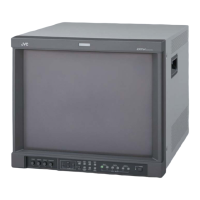(No. 52152) 1-67
Adjustment Signal Function
Adjustment Data
RG B
COMMON
Drive WX01 – WX03
Cut off WX04 WX05 WX06
1080/60i
Drive WJ01 – WJ03
Cut off WJ04 WJ05 WJ06
1080/50i
Drive WN01 – WN03
Cut off WN04 WN05 WN06
1080/24psF
Drive WP01 – WP03
Cut off WP04 WP05 WP06
720/60p
Drive WR01 – WR03
Cut off WR04 WR05 WR06
720/50p
Drive WT01 – WT03
Cut off WT04 WT05 WT06
480/60i
Drive WF01 – WF03
(Common to 576/50i)
Cut off WF04 WF05 WF06
480/60p
Drive WH01 – WH03
(Common to 576/50p)
Cut off WH04 WH05 WH06
COMPONENT SIGNAL WHITE BALANCE (LOW: D65) ADJUSTMENTS
Measuring Instruments Signal generator (10-step gray scale signal)
Color temperature meter
Card (Slot) Component/RGB Input Card (Slot 1)
Test Points
Adjustment Points W*01 (Drive (R)), W*03 (Drive (B)), W*04 (Cut Off (R)),
W*05 (Cut Off (G)), W*06 (Cut Off (B)) [Service Menu]
Notes:
• Perform the following adjustments after completing the Low-Light White Balance (Reference Value) Adjustment.
• Set the COLOR TEMP./BAL. data in the Setup Menu to “00”.
• The values adjusted with WX become the reference values for the following adjustment. When this data is changed,
it is required to re-adjust the white balance data of all of the adjustment signals (Component, NTSC and PAL).
When re-adjusting the 1080/60i signal, use the WJ.
(1) Apply the 1080/60i component 10-step gray scale signal to INPUT A.
(2) Set “COLOR TEMP.” of COLOR TEMP./BAL. in the Setup Menu to LOW.
(3) Set the PHASE, CHROMA, BRIGHT and CONTRAST potentiometers on the front panel to the center click positions.
(4) Adjust WX01 and WX03 in the Service Menu using the color temperature meter so that the color temperature is set as shown
below.
(Do not touch WX02.)
Color temperature: LOW (D65). x = 0.313, y = 0.329 (Reference value)
(5) Ensure that the white balance tracking is correct from the gray scale steps with lower color temperatures to those with higher
color temperatures. If the white balance tracking is deviated in darker steps, adjust WX04 to WX06 to correct it.
(Do not set the values of WX04 to WX06 no more than “50”.)
(6) Vary the adjustment signal and adjustment data, and re-perform adjustments in steps 1 to 5 above (see Table 19).
Table 19

